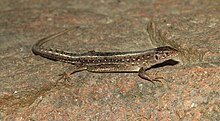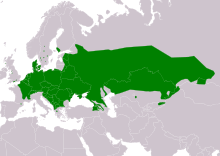
Back سحلية رشيقة Arabic سحلية الرمل ARZ Adi kərtənkələ Azerbaijani Яшчарка порсткая Byelorussian Яшчарка порсткая BE-X-OLD Ливаден гущер Bulgarian Llangardaix pirinenc Catalan Banghitaw CEB Ještěrka obecná Czech Zwëczajnô wieszczórka CSB
| Sand lizard | |
|---|---|

| |
| Male | |

| |
| Female | |
| Scientific classification | |
| Domain: | Eukaryota |
| Kingdom: | Animalia |
| Phylum: | Chordata |
| Class: | Reptilia |
| Order: | Squamata |
| Family: | Lacertidae |
| Genus: | Lacerta |
| Species: | L. agilis
|
| Binomial name | |
| Lacerta agilis | |

| |
| Range of L. agilis Extant, resident
| |

The sand lizard (Lacerta agilis) is a lacertid lizard distributed across most of Europe from France and across the continent to Lake Baikal in Russia.[2][3] It does not occur in European Turkey. Its distribution is often patchy.[4] In the northern extremes of the sand lizard's distribution, such as along the southern English coast of Great Britain, it can only survive by inhabiting seaside heathlands, where the ground temperature is sufficiently elevated from the Sun's rays; the warmth is also critical to the lizard being able to successfully incubate their eggs, which are laid in sand.
Males are known for their bright colorations and aggressive, possessive behaviors when seasonally competing for females. Uniquely, when compared to other squamates, the sand lizard's mating season is very short, with the males displaying more selectivity among families. Males are typically more “picky” with their chosen mates than the females, and more so than other lizard species, as well. Females usually only lay a single clutch of eggs per year.
Sand lizards spend most of their time basking, foraging, or under vegetation and prefer to live in diverse habitats. Males have their own home territories that are very wide and often overlap with other males. These males compete with each other while females have smaller home territories that neighbor each other and will sometimes share habitats with each other. They can live for up to ten years and because of this relatively long lifespan, they are sometimes subject to inbreeding and producing malformed offspring.
- ^ Aghasyan, A.; Avci, A.; Tuniyev, B.; et al. (2021). "Lacerta agilis". IUCN Red List of Threatened Species. 2021: e.T157288A49644624. doi:10.2305/IUCN.UK.2021-2.RLTS.T157288A49644624.en. Retrieved 12 November 2021.
- ^ M., Smith (1969). The British Amphibians and Reptiles. Collins, London, UK.
- ^ "Lacerta Agilis LINNAEUS, 1758". www.lacerta.de. Retrieved 30 August 2021.
- ^ Arnold, E. Nicholas; Arribas, Oscar; Carranza, Salvador (2007). "Systematics of the Palaearctic and Oriental lizard tribe Lacertini (Squamata: Lacertidae: Lacertinae), with descriptions of eight new genera" (PDF). Zootaxa. 1430. Auckland, New Zealand: Magnolia Press: 1–86. doi:10.11646/zootaxa.1430.1.1. ISBN 978-1-86977-097-6. Retrieved 12 July 2017.
© MMXXIII Rich X Search. We shall prevail. All rights reserved. Rich X Search
